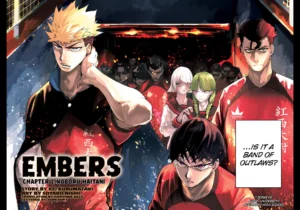
This edition caused quite a stir due to the classic Hajime no Ippo and a highly controversial chapter! Could readers’ disbelief over the series’ developments impact the legendary boxing manga? In addition, we have the five-year anniversary celebration of Kakkou no Iinazuke and much more. Join us as we analyze the second-largest shonen magazine in Japan, starting with the TOC:
1 – Kakkou no Iinazuke (First Color Pages) Ch. 236
2 – Kaijin Fugeki Ch. 28
3 – Kanojo, Okarishimasu Ch. 362
4 – Hajime no Ippo (Promotional Color Page) Ch. 1481
5 – Mayonaka Heart Tune Ch. 63
6 – Shangri-La Frontier ~Kusoge Hunter, Kamige ni Idoman to su Ch. 208
7 – Seitokai ni mo Ana wa Aru! Ch. 120
8 – Suruga Meteor Ch. 03
9 – Amagami-san Chi no Enmusubi Ch. 168
10 – Daiya no Ace Act II Gaiden – Teitou VS Ugomori Ch. 05
11 – Kuroiwa Medaka ni Watashi no Kawaii ga Tsujinai Ch. 164
12 – Blue Lock Ch. 290
13 – Megami no Café Terrace Ch. 183
14 – Ao no Miburo: Shinsengumi-hen Ch. 37
15 – Fumetsu no Anata e Ch. 196-1
16 – Irozuku Monochrome Ch. 22
17 – Gachiakuta Ch. 125
18 – Mokushiroku no Yonkishi Ch. 178
19 – Yumene Connect Ch. 20
20 – Banjou no Orion Ch. 45
21 – Kanan-sama wa Akumade Choroi Ch. 127
22 – Sentai Daishikkaku Ch. 169
23 – Love Forty Ch. 28
24 – Batchiri Scratch! Ch. 2
Absences: Yowayowa Sensei Ch. 106, Ahiru no Sora Ch. 616 (Hiato)

After a cover featuring an idol, the first color pages go to Kakkou no Iinazuke, celebrating its fifth anniversary.
This romantic comedy is one of the most popular in the magazine, and early on, many believed it could reach the same level of popularity as Gotoubun no Hanayome once it got an anime adaptation. Well, that didn’t happen, but it’s still an important series for the magazine.
The anime’s second season, as repeatedly highlighted by the editorial team, will be released in 2025 and may help slow down the manga’s gradual sales decline. However, a complete reversal seems unlikely. Kakkou no Iinazuke remains profitable as a franchise through licensed products and marketing collaborations.
Finally, a new arc focusing on Sachi has begun, along with comments from the series’ voice actors. A well-deserved and typical promotion. 2025 is unlikely to be the final year for Kakkou no Iinazuke.
Taking second place is Kaijin Fugeki, an action series by the renowned author Oh Great. It’s clear that Kaijin Fugeki has hit a plateau, with no growth in social media numbers and its volumes consistently selling around 15,000 copies per month.
However, Kaijin Fugeki has two potential opportunities for growth—one short-term and one long-term. The short-term chance is performing well in manga awards like the Tsugi Manga or Manga Taisho (by the way, Fel wrote an article about it, check it out!). These awards aren’t exactly mainstream but can persuade regular manga readers to give the series a chance. Some clear examples from last year include Girl Meets Rock (Fuutsu no Keionbu) and Kagurabachi, both of which saw significant growth after winning at Tsugi Manga. Kaijin will face tough competition from series like Madan no Ichi, but even a strong ranking could help.
The long-term plan is obviously an anime adaptation. Kaijin will likely get one at some point, as most Magazine series sell their TV rights quickly. However, the anime would need a strong production team—one of the series’ biggest appeals is its massive-scale events and stunning artwork. This week’s chapter was likely placed near the front because it’s one of those visually breathtaking ones. I’m rooting for Kaijin to get the recognition it deserves.
Kanojo, Okarishimasu rounds out the top three. As I’ve mentioned before, this is a pivotal arc for one of Shonen Magazine’s biggest series, so it deserves to appear at the top regularly.
There is also a marketing collaboration between Hajime no Ippo and Family Mart, one of Japan’s largest convenience store chains. That said, what really matters is the chapter itself and the reactions it has sparked.
I try not to spoil chapters in this column since it focuses on magazine analysis, but Ippo‘s case is difficult to ignore. For those reading Ippo, you’ll know what I’m referring to. For those who aren’t and want to avoid spoilers, let’s just say this: it’s a highly unexpected and controversial conclusion to a long-running arc.
The author of Ippo, George Morikawa, is extremely respected in Japan. He created a classic that has lasted for decades and is a strong advocate for the manga industry. However, even so, Morikawa received heavy criticism from local readers—something incredibly rare.
I can’t recall a previous Ippo chapter that received this level of backlash. This development has also led some readers to bring up long-standing issues with the series: Ippo‘s lack of focus as the protagonist, short chapters, slow publication pace, etc. Of course, I believe some of these criticisms go beyond personal opinion and become somewhat exaggerated. Morikawa is older now, and it’s undeniable that he needs more breaks and a steady pace to continue publishing the series.
Now, the question: could this affect Hajime no Ippo‘s popularity? In the long run, I don’t think so. Fans who are passionate enough to be this upset are not the “average” readers, and even among them, I believe the reaction is somewhat exaggerated. What really matters now is how Morikawa will steer the story from here. This could even mark the beginning of Ippo reclaiming a more central role, though it’s likely that the focus will soon shift to Sendo. We’ll keep an eye on further developments.
In fifth place, Mayonaka Heart Tune focuses on Shinobu in the current arc. I believe she’s the least developed heroine in the story so far, so it’s a good decision by the author to give her more attention now. Harem stories need this kind of rotation since each heroine has their own dedicated fans.
Sixth place goes to Shangri-La Frontier, which wraps up its current arc after one of the manga’s biggest battles! The story stays faithful to the original web novel’s pacing, preserving as many battle details as possible. Does that make the weekly chapters feel slow? Yes, but it’s worth it. Readers seem satisfied so far.
Seitokai ni mo Ana wa Aru! takes seventh place with a chapter focused on the teachers, without any of the student council members who give the manga its title. I mention this because it’s interesting how Seitokai can change its focus weekly without losing readers—every character gets their moment, no matter how small.
It’s also impressive to see the sheer number of collaborations and merchandise for Seitokai each week. There are always new announcements and big brands involved. For example, this week, they’re promoting a collaboration with Donki, a major retail chain that anyone who has visited Japan would recognize. The anime is on its way…
Eighth place goes to Suruga Meteor, now at its third chapter. This week’s chapter had extra pages again, reaching 36 this time.
Sticking to the traditional formula, this issue sees the team facing off against one of the top schools in the region for a practice match. Suruga shocks the spectators, who were expecting a one-sided defeat—he launches balls at 160 km/h, overwhelming the opposing batters. Then, a new rival steps up to challenge him.
It’s a simple setup, but well-executed, with solid artwork and presentation. The problem is that Suruga Meteor isn’t really grabbing attention. Its initial reception feels very similar to Love Forty—hardly any discussion, and the few comments just describe it as “traditional.” The manga’s official page even tried to market it as “a boy with a big backside playing baseball,” but that promotional angle didn’t seem to stick, unfortunately.
Ninth place goes to Amagami-san, wrapping up its current arc centered on Yuna, which has been running for 16 weeks—about the same length as the anime’s duration. This is a series that didn’t manage to capitalize on its adaptation and fell behind compared to Kanojo, Okarishimasu, Kakkou no Iinazuke, and Megami no Café Terrace.
In tenth place, Daiya no Ace reaches the halfway point of its special publication. Once again, it’s positioned near Suruga Meteor, though their rankings are flipped this time.
Eleventh place goes to Kuroiwa Medaka, another series that hasn’t leveraged its anime to gain popularity and remains in the second tier. It ranks closely alongside Amagami-san on Magazine Pocket, both being decently popular on the platform but still struggling to surpass Megami no Café Terrace there.
Twelfth place belongs to Blue Lock, with another chapter continuing the current match. Someone had asked about the source of the research I mentioned in the previous article—it’s from a GEM Partners study (obviously in Japanese). But as I’ve said before, Blue Lock has a broad appeal, selling well to both male and female audiences.
Already mentioned twice in this review, Megami no Café Terrace takes the thirteenth spot in the TOC. In 10 days, its latest volume sold 27,317 copies—just 300 fewer than Kakkou no Iinazuke, which also had a volume release this month. The two series are basically tied in sales nowadays, so if Kakkou no Iinazuke gets more anime adaptations, maybe Megami no Café Terrace will too.
In fourteenth place, Ao no Miburo continues its coverage of the Ikedaya Incident, the most famous historical event involving the Shinsengumi. The story has taken a darker and more violent turn than usual, which is already quite realistic for a samurai manga.
Fifteenth place goes to Fumetsu no Anata e, which seems to be nearing the end of its arc that has been running for over a year. The challenge with predicting this manga’s direction is its irregular chapter length, but a 2025 conclusion wouldn’t be surprising. That said… where’s the anime?
In sixteenth place, Irozuku Monochrome wraps up its opening arc and announces the start of a new one, introducing more demons and expanding beyond the church setting that has defined the story so far.
This seems like a way to add variety and ease concerns from readers who worried the story might become too repetitive. The manga isn’t growing much in terms of volume sales, but it ranked an excellent fifth place this week among romance series on Magazine Pocket.
Seventeenth place goes to Gachiakuta, which usually ranks around this spot. This placement likely has more to do with reading flow than actual performance. And as always, this chapter is another artistic spectacle. Now, we wait for the anime adaptation announcement at AnimeJapan.
Eighteenth place, Mokushiroku no Yonkishi, continues its tournament arc, reminiscent of Budokai Tenkaichi. One of Nakaba’s greatest strengths as a creator is his fight choreography—it’s among the clearest and easiest to follow in the modern manga industry. It’s great to see him getting the chance to showcase that talent week after week.
Yumene Connect appears in the nineteenth position, which is not necessarily due to its popularity but more likely because of the boundaries that the ecchi genre constantly pushes.
Volume 2 has sold nearly 6,000 copies in 10 days and is expected to surpass the 8,000 copies of Volume 1. However, as I always point out, digital sales are crucial for measuring real popularity, and Yumene consistently ranks in the top 3 comedies on Magazine Pocket. That’s an excellent performance for a newcomer.
Another relevant metric is the number of reviews on Amazon Japan. Irozuku has 62 and 34 reviews for its first and second volumes, respectively, while Yumene has an impressive 132 and 80—numbers comparable to established romcoms in the magazine. The comparison becomes disheartening when Love Forty and Batchiri Scratch don’t even reach double digits in reviews. Yumene is also extremely popular on social media, with a large number of followers and frequent viral moments.
If this online popularity translates into strong placements in awards, Yumene has the potential to grow even further as one of the magazine’s future highlights.
Banjou no Orion takes the twentieth spot in the TOC, which is unusual but happens due to rotation. The manga remains well-regarded by both readers and editors.
In twenty-first place is Kanan-sama, moving towards the conclusion of one of its most significant arcs so far. Other than that, everything remains the same—the manga has consistently sold at the same rate since its debut, maintaining similar rankings online. That should be enough until an anime adaptation comes along.
In the third-to-last position, Sentai Daishikkaku continues its revealing flashback. Its constant presence at the bottom of the magazine is disappointing, as it suggests that the editorial team has lost confidence in the manga after its lack of growth following the anime adaptation. While it’s unlikely to be outright canceled, it no longer seems to be a priority—except when they need a color page to promote the anime.
And finally, the two most likely candidates for cancellation close out the edition: Love Forty with a dialogue-heavy chapter and Batchiri Scratch with a chapter focused on secondary characters. Strange.
I’m still hoping for a promising new series that will break the 20,000 monthly sales mark—something that hasn’t happened since I started writing here on the site. Until the next article!





